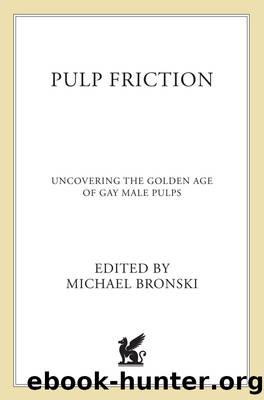Pulp Friction by Michael Bronski

Author:Michael Bronski
Language: eng
Format: epub
Publisher: St. Martin's Press
PART FOUR
Out of the Twilight World:
The Sexual Revolution Goes Lavender
The emergence of the overtly sexual gay male pulp novel did not occur in a vacuum. Not only had the radical change in censorship laws allowed the publication, and, what was just as important, the distribution, of books such as Gay Whore or Hollywood Homo, but gay male consumer patterns had also changed: There were now more men who were out and unafraid to purchase books with frankly homosexual themes from the racks in drugstores, bus stations, and in the newly emerging venue of the “adult bookstore.”
But other cultural changes as well encouraged—in the broadest sense—the evolution of this genre. Commonly enough in the 1950s, gay male themes were accepted as part of mainstream literature. Heterosexuals could read about, and learn about, the gay male world in books such as Harrison Dowd’s The Night Air or Michael De Forrest’s The Gay Year. These books were, to a large degree, marketed to a heterosexual readership. And straight readers were curious and often eager to read about the “shadow world” of homosexuality. Some of this curiosity may have been prurient, but much of it was probably honest interest. Heterosexuals have always been curious about the lives of gay men and lesbians, and novels that dealt with gay characters and gay themes were the best, and the easiest, means of satisfying that curiosity.
But it was not only novels that illuminated the lavender shadows for heterosexuals. From the 1950s on, nonfiction works also shed light on this mysterious world. Perhaps not surprisingly many of these nonfiction books were not as literary, sophisticated, or nonjudgmental as the novels of the same period. Often, these books took the tone of a exposé that would guide the heterosexual reader through the terrifying “secret world” of the homosexual. The most famous of these was the Confidential series by Jack Lait and Lee Mortimer. The authors, newspaper columnists on the theater beat, covered the sleazy underworlds of New York, Washington, and Chicago in bestsellers that titillated as they informed. Chapter 15 in Washington Confidential (1951) is titled “Garden of Pansies” and begins: “If you’re wondering where your semi-boy is tonight, he’s probably in Washington.” Writing in semi-tough-guy tabloidese, Lait and Mortimer spell it out for their readers:
The only way to get authoritative data on fairies is from other fairies. They recognize each other with a fifth sense immediately, and they are intensely gregarious. One cannot snoop at every desk and count people who appear queer. Some are deceptive to the uninitiated. But they all know one another and have a grapevine of intercommunication as swift and sure as that in a girls’ boarding school. They have their own hangouts, visit one another, and cling together in a tight union of interests and behaviors.
And where are these hangouts? Lait and Mortimer mince no words:
Their chief meeting place is in leafy Lafayette Square, across Pennsylvania Avenue from the White House.… They also gather in Franklin Park, a few blocks away, in the center of the business district.
Download
This site does not store any files on its server. We only index and link to content provided by other sites. Please contact the content providers to delete copyright contents if any and email us, we'll remove relevant links or contents immediately.
| African-American Studies | Asian American Studies |
| Disabled | Ethnic Studies |
| Hispanic American Studies | LGBT |
| Minority Studies | Native American Studies |
Cecilia; Or, Memoirs of an Heiress — Volume 1 by Fanny Burney(31333)
Cecilia; Or, Memoirs of an Heiress — Volume 3 by Fanny Burney(30934)
Cecilia; Or, Memoirs of an Heiress — Volume 2 by Fanny Burney(30889)
The Great Music City by Andrea Baker(21313)
We're Going to Need More Wine by Gabrielle Union(18073)
Bombshells: Glamour Girls of a Lifetime by Sullivan Steve(13108)
Pimp by Iceberg Slim(12931)
All the Missing Girls by Megan Miranda(12748)
Fifty Shades Freed by E L James(12451)
Norse Mythology by Gaiman Neil(11883)
Talking to Strangers by Malcolm Gladwell(11877)
Crazy Rich Asians by Kevin Kwan(8349)
Mindhunter: Inside the FBI's Elite Serial Crime Unit by John E. Douglas & Mark Olshaker(7834)
The Lost Art of Listening by Michael P. Nichols(6474)
Enlightenment Now: The Case for Reason, Science, Humanism, and Progress by Steven Pinker(6405)
Bad Blood by John Carreyrou(5769)
The Four Agreements by Don Miguel Ruiz(5511)
Weapons of Math Destruction by Cathy O'Neil(5037)
We Need to Talk by Celeste Headlee(4869)
